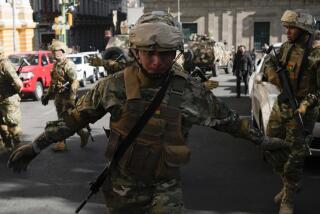Rebels Leave Strongholds : U.S. Warplanes Help Combat Anti-Aquino Coup : Cory Calls Foe All but Vanquished
- Share via
MANILA — Mutinous soldiers left their last strongholds in Manila late today after U.S. warplanes intervened to help put down the most serious coup attempt since President Corazon Aquino took office in 1986.
Rebels abandoned the government television station and Villamor air base, which they had seized before dawn, and hundreds of mutinous marines marched out of Ft. Bonifacio, their home garrison.
Hundreds of mutineers then began marching down a major thoroughfare toward Camp Aguinaldo, headquarters of the armed forces general staff.
What they intended to do at the camp was not clear, but pro-government forces did not try to stop them. Occasionally, some of the marchers would fire shots into the air or point their rifles at journalists trying to follow them.
Gen. Renato de Villa, military chief of staff, said the sixth coup attempt against Aquino had failed. Manila radio stations broadcast a statement from the president late today saying the “enemy is routed, but is not yet vanquished.”
U.S. Air Force F-4 Phantom jets from Clark Air Base, 50 miles north of Manila, roared over the city today, halting rebel air attacks. The rebels had raided the presidential palace, military camps and a television station earlier in the day with planes and helicopters.
The American action enabled Aquino’s government to consolidate its forces and block rebels from moving against the palace and other points in the capital.
In Washington, Rear Adm. Ted Sheafer of the Defense Intelligence Agency said the rebels controlled all the country’s 14 T-28 attack planes, based at Sangley, and about 20 attack helicopters at Villamor.
The only attack aircraft under the government’s control were nine F-5 jet fighters, Sheafer said.
The American F-4 Phantom pilots flying air cover warned the Philippine pilots over the radio to stay on the ground and not to try to take off again, Williams said.
None of the rebel flyers tried to take off or challenge the American pilots, who had orders to shoot if necessary to defend government forces, officials said.
“No U.S. planes have fired any shots or intercepted any rebel aircraft,” Williams said. “No U.S. personnel have been directly involved in any of the fighting between rebel forces and the government of the Philippines.”
None of the mutinous soldiers questioned would say who directed the revolt. Rebel sources said the leaders included renegade Lt. Col. Gregorio (Gringo) Honasan, who led an August, 1987, coup attempt in which at least 53 people were killed.
Honasan has been at large since his escape from prison in April, 1988. He supported Aquino when she came to power in February, 1986, in a military-civilian uprising that ousted the late President Ferdinand E. Marcos, but he turned against her because of the government’s alleged failure to end corruption and curb a communist insurgency.
Before the U.S. intervention, two T-28 aircraft bombed and rocketed Malacanang Palace compound.
More to Read
Sign up for Essential California
The most important California stories and recommendations in your inbox every morning.
You may occasionally receive promotional content from the Los Angeles Times.












